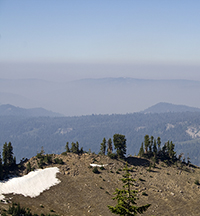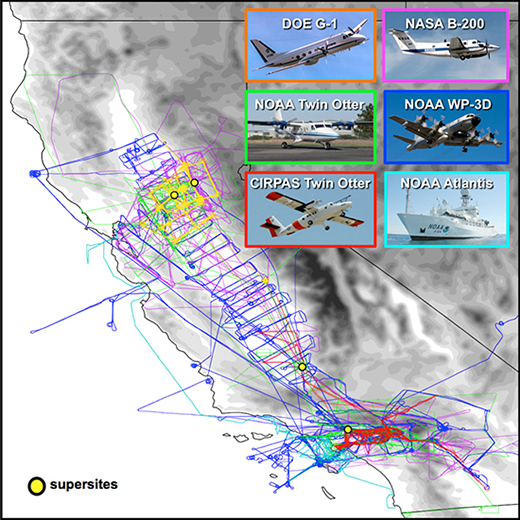Atmospher Sci & Global Chg
Research Highlights
November 2014
Mountains and Winds Confound Particle Distribution
New field data reveals unexpected atmospheric agitators

Dense layers of smog from forest fires and pollution frequently hang over the Sierra Nevada Mountains in California. Scientists are working to identify and describe the atmospheric particles forming these layers and how they interact to improve climate model projections and air quality prediction. Enlarge Image.
Results: Untangling complex relationships requires understanding and facts. Applying both, Pacific Northwest National Laboratory led research finding the true culprits instigating layers of tiny atmospheric particles above California's central valley. Contrary to previous assumptions, local recirculation patterns, affected by winds interacting with the unique topography of the Sierra Nevada Mountains, create these particle layers. Global model simulations had incorrectly tied the layers to a mix of long-range transport of pollution from Asia and local emissions of soot and particles from burning fossil fuels. This research improves understanding of how the particles impact the regional climate and policy makers' decisions on how to regulate these emissions.
Why It Matters: Atmospheric aerosols are tiny particles of soot and chemicals from combustion of fossil fuels and vapor from natural sources, such as trees and vegetation. Characterizing these particles and tracking them and their interactions in the atmosphere is a major challenge for air quality and climate models. Errors in aerosol predictions are a result of two sources of uncertainties: the emission rates from human-caused and natural sources; and simulations of the specific atmospheric processes that affect the lifecycle of these particles in models. Using direct observations and unique modeling tools, researchers can tackle both these challenges that affect projections of future heating and cooling of the Earth's atmosphere.
Methods: Researchers from PNNL and their collaborators collected extensive meteorological, chemical, and aerosol measurement data at ground sites and aloft by research aircraft over a two-month period during two field investigations. The data from these campaigns were coupled with regional model simulations. This study integrated operational monitoring data and the wide range of meteorological, chemistry, and aerosol data collected between May and June of 2010 during the Carbonaceous Aerosol and Radiative Effects Study (CARES) and California Nexus of Air Quality and Climate Experiment (CalNex) field campaigns into a single publicly available data set as part of an "aerosol testbed." The testbed was used to comprehensively evaluate the performance of one regional aerosol model, the Weather and Research Forecasting model coupled with chemistry (WRF-Chem), and understand how local and distant aerosol sources affect aerosol concentrations over California.

Sampling paths over California by aircraft and ship instrument platforms (lines) along with "supersite" measurement locations (yellow circles) during the CARES and CalNex field campaigns enabled direct observations of the complex mixing of various sourced particles in the atmosphere.
Their findings show that in global model simulations, the long-range transport of aerosols from Asia was overestimated, and anthropogenic emission rates of black carbon and other aerosol precursors over California were too high. Both of these factors can lead to erroneous estimates of how aerosols impact regional climate and decisions on how to regulate particulate emissions. The regional model also showed that observed aerosol layers above the central valley were not due to long-ranged transport as expected, but to local recirculation patterns associated with the interaction of the winds and topography of the Sierra Nevada that cannot be resolved by current climate models.
The unprecedented amount and type of measurements provided a unique dataset for modelers to test, evaluate, and improve the treatment of aerosol processes in regional and global models.
What's Next? The CARES/CalNex testbed is being used to test and improve simulations of secondary organic aerosol formed by the atmospheric mixing of human-caused and natural-sourced trace gases. Scientists will also use the testbed to evaluate how the newly formed particles affect the size distribution measurement of all particles.
Acknowledgments
Sponsors: This work was supported by the U.S. Department of Energy's (DOE) Office of Science, Office of Biological and Environmental Research, Atmospheric System Research program, and the U.S. National Oceanic and Atmospheric Administration's Atmospheric Composition and Climate Program. Measurements used by this study were obtained with support of DOE's Atmospheric Radiation Measurement (ARM) Climate Research Facility, NOAA's Climate Change and Air Quality programs, and the California Air Resources Board.
Facilities: ARM Climate Research Facility, a national scientific user facility sponsored by the DOE's Office of Biological and Environmental Research and located at PNNL; and the PNNL Institutional Computing for model simulations
Research Team: Jerome Fast, Ying Liu, Mikhail Pekour, John Shilling, ManishKumar Shrivastava, Chen Song, V Vinoj, and Rahul Zaveri, PNNL; James Allan and Jonathan Taylor, University of Manchester; Roya Bahreini, Patrick Hayes, John Holloway, Jose Jimenez, and Anne Perring, University of Colorado; Jill Craven, Andrew Metcalf, and John Seinfeld, Caltech; L Emmons and Alma Hodzic, NCAR; Richard Ferrare and Chris Hostetler, NASA Langley; Haflidi Jonsson, Center for Interdisciplinary Remotely Piloted Aerosol Studies; Shang Liu, Los Alamos National Laboratory; John Nowak, Aerodyne Research; Lynn Russell, Scripps Institute of Oceanography-UC San Diego; Art Sedlacek and Steven Springston, Brookhaven National Laboratory; R Subramanian, Carnegie Mellon University; and Qi Zhang, University of California Davis.
Research Area: Climate & Earth Systems Science
Reference: Fast JD, J Allan, R Bahreini, J Craven, L Emmons, R Ferrare, PL Hayes, A Hodzic, J Holloway, C Hostetler, JL Jimenez, H Jonsson, S Liu, Y Liu, A Metcalf, A Middlebrook, J Nowak, M Pekour, A Perring, I Pollack, L Russell, T Ryerson, A Sedlacek, J Seinfeld, A Setyan, J Shilling, M Shrivastava, S Springston, C Song, R Subramanian, JW Taylor, V Vinoj, C Warneke, Q Yang, RA Zaveri, and Q Zhang. 2014. "Modeling Regional Aerosol Variability over California and Its Sensitivity to Emissions and Long-Range Transport during the 2010 CalNex and CARES Campaigns." Atmospheric Chemistry and Physics 14:10013-10060. DOI:10.5194/acp-14-10013-2014.
